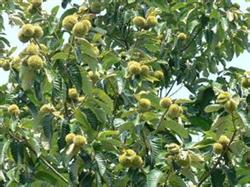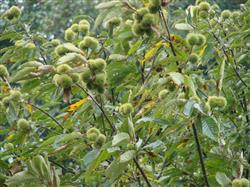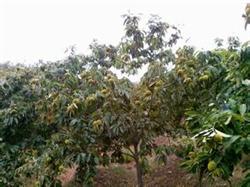High-yield cultivation techniques of Organic Chestnut

In addition to the high requirements for environmental factors such as atmosphere and water quality, organic chestnut is also strict in management. its cultivation techniques mainly include the following aspects: first, establishing a garden. Choose a place. It is suitable to build a garden on sunny slope, semi-sunny slope, hilly or river flat with slope below 30 degrees, soil pH 5.5-7.0, groundwater level below 1 meter, sandy soil or sandy loam. two。 Prepare the ground. Horizontal trench preparation: suitable for 10-20 degree hills and mountains. In the rainy season of the year before planting trees, according to the designed row spacing, the trenches were piled around the mountains along with the situation. The trenches were 30 centimeters high and 60 centimeters wide. The mountain soil under the trenches was motionless to prevent soil erosion, and there were overflow vents at both ends of the horizontal trenches. Burrowing ground preparation: suitable for sloping land or flat land below 10 degrees. The length × width × depth is 50cm × 60cm × 50cm × 60cm. Fish scale pit preparation: suitable for slopes of more than 20 degrees. The length × width × depth is 50 cm × 40 cm × 30 cm. 3. Land preparation requirements. One is to turn against the slope, pouting outside and carrying water in the mouth. Second, to be horizontal, there can be no uneven, continuous rainfall of 100 mm, there can be no phenomenon of breaking trenches, destroying dams and washing seedlings. Second, planting 1. Select seedlings. The robust seedlings of 1 ~ 2 years old, more than 0.8 cm in diameter, free of diseases and insect pests, large mechanical damage, uniform size and more than 20 cm length of main and lateral roots were selected. two。 Colonization. The row spacing of the initial planting density is 2 × 3 meters, 111 plants per mu. After that, with the expansion of the crown and closure of the canopy, the plants are gradually removed and the rows are separated. 3. Planting time. In autumn and winter, the soil was planted before freezing (from early November to the end of November) or before Qingming Festival in spring, and after soil thawing (from March 15 to early April). 4. Planting method. Use pruning shears to trim the roots of the seedlings and cut off the stale wounds before planting the trees. When burying the soil to the split root (pentagram), pour a lot of water until the pit is full, and then bury it strictly, so that the average adult can't pull out the seedlings with one hand. The thickness of soil cover of one-year-old seedlings is 10 cm higher than that of seedlings, and that of two-year-old seedlings is 20 cm higher than that of original soil prints. When planting trees in autumn and winter, the seedlings should not be exposed at night to avoid freezing the bare roots. After planting, the seedlings should be overwhelmed against the cold, all buried in the soil, do not accumulate the soil to bury the part, in order to prevent part of the dead seedlings. Plastic film should be covered in spring planting to increase temperature and moisture, promote seedling growth and development, and improve the survival rate. Third, grafting 1. Variety selection. It is suitable to select the varieties with obvious resistance to Chinese chestnut diseases and insect pests, such as Yanshan short branch as the main variety, Yanming as the pollination variety, and the suitable ratio is 8: 10: 1. two。 Selection and storage of scions. The scion should choose an annual fruiting mother branch (hammer code) with a diameter of 0.3 to 0.8 cm, strong growth and no diseases and insect pests. In winter (dormant period), the scion was stored in the cellar to keep the scion fresh and dormant. 3. Grafting. Grafted from mid-April to early May in the second or third year of planting, the height grafting of big trees can last until late May. 4. Grafting method. Subcutaneous grafting (skin grafting) is appropriate. Cut off the rootstock 10cm to 20cm above the ground, and cut the cut smooth with a knife. The lower end of the scion is 3 cm long, and the left, middle and right side of the scion is 0.2 cm long. The upper part of the small face and the large face are gently cut off with a knife to expose the green skin, and the scion is cut and contained in the mouth to be inserted. It is better to have 3% 5 buds on the scion, not too long. Cut the flattened rootstock longitudinally with a grafting knife, reach as deep as the xylem, gently pry open the cortex, then insert the cut scion, facing inward and close to the xylem, and the upper part of the slope is exposed 0.2 cm to 0.3 cm. The rootstock with a diameter of 2 cm can insert 2 to 3 scions, and the scion of a high-grafted tree can be inserted more. Tie it up with a plastic strip with a large elasticity about 3 centimeters wide, and wrap it up to 3 centimeters above the cross section of the rootstock in the shape of a cylinder. A handful of soil is casually loaded into the empty cylinder and compacted with hands. It is appropriate that the soil in the tube is 2 centimeters thick. In order to prevent insects and moisturize, you can also put on a plastic bag, the lower mouth is tied with string, and the scion bud can be pierced or torn open in time after the scion bud germinates and spreads its leaves. 5. Post-management. After the scion survived, the sprouting on the rootstock under the interface should be removed in time. When the new tip of the scion grows to 30 ~ 40 cm, pick the heart in time, leave 6 ~ 8 leaves on the secondary shoot and pick the heart for two or more times. After two months or so, untie the plastic strip according to the growth condition, and then wrap it around the interface to protect the scion. Fourth, plastic surgery and pruning 1. A tree. The low stem and short crown is open heart-shaped, with a stem height of 30 cm, a crown height of 2.5 cm, a main branch of 2 cm, no more than 4 at most, and a base angle of 50 °60 °. One or two lateral branches or directly bearing fruiting branches can be selected on each main branch. two。 Pick the heart. The summer shears in the first and second years after grafting were mainly coring, when the trunk or main branch extended to the target tree length, when the other new shoots reached 20 cm, the tip was removed, and when the second or third shoots grew to 20 cm, 6 leaves were left for the second and third times, and the coring stopped in the middle of August. 3. Wipe the buds. When the bud sprouts, the upper side of the strong branch leaves 4-5 big buds, the golden mean branch leaves 1-3 big buds, the rest of the buds are erased, the principle of erasing buds is small and big, go down and stay on, sparse and thin, weak and strong. 4. Winter pruning. The elongated branches of backbone branches such as main branches and lateral branches are moderately truncated or retracted, and the severity of truncation is determined according to the difference of variety, tree potential, tree age and space. There is no space for the thinning of the developing branches, and the spatial developing branches are cut short and cultured into the fruiting branch group, thinning as little as possible. If there are more fruiting mother branches on the same branch, the ones with the strongest power at the end are truncated or thinned, leaving the sturdy fruit of the mean and thinning the weak ones in the lower part. Three or four strong branches were juxtaposed, and the three-strand forks and four-strand forks were treated in the way of thinning 1 section 1 slow 1 or thinning 1 section 1 slow 2. Remove thin and weak, disease and insect pests, overlap, over-dense branches and chicken claw code, fishbone code and some strong and prosperous terminal branches. Retract the long, weak fruiting branch group to the lower branch. In the dense planting high-yield garden, there were 10 per square meter of crown projection area, and 6 per square meter of crown projection area in poor hilly and mountainous areas. Fifth, select varieties with strong resistance to Chinese chestnut diseases and insect pests for pest control. Scrape the bark in early spring and burn it. Before sprouting, the whole tree was sprayed with 3-5 Baumedu stone sulfur mixture. In a special year, when the occurrence of diseases and insect pests is serious, refer to the methods recommended in GB/T19630.1-2005 and the plant, mineral or microbial plant protection products or preparations in Appendix B to control them. Collect fallen leaves in late autumn and destroy them to eliminate the source of overwintering diseases and insect pests. Sixth, florescence management 1. Boron spray. During the full flowering period of female flowers (mid-June), borax was sprayed 400x before 10:00 and again after an interval of 7 days. It should be dissolved in boiling water to prevent recrystallization, evenly sprayed on both sides of female flowers and leaves, and timely supplementary spraying in case of rain after spraying. two。 Shu Xiong. When the male inflorescence of the main variety is about 2 cm, the male inflorescence of the main variety will be removed and 2-3 male inflorescences will be left under the mixed inflorescence to meet the needs of pollination. The mixed inflorescence is characterized by a purplish reddish apex, and the lower male inflorescence is abruptly shorter than the lower male inflorescence and must be retained. Pollination varieties should not be sparse. 7. Fertilizer and water management 1. Loosen the soil and expand the hole to apply base fertilizer. After the fruit is harvested, the hole is expanded, and the root system is drawn out from the place where there are few outer roots of the crown, and the root system is drawn out with a depth of 60cm to 80cm, expanding one to two sides a year, which is completed year by year. When backfilling, first fill the base fertilizer in the ditch, and then fill the topsoil, cover it with raw soil, and pour it thoroughly with water that meets the requirements of GB5084 after deep turning and expanding the hole. In general, the first fruiting trees apply 25,70kg organic fertilizer, 80kg to 150kg in the full fruit stage, or according to the ratio of fruit to fertilizer 1: 5: 10, it can also be mixed with an appropriate amount of natural (or through physical methods, without the addition of chemical synthetic substances) phosphate rock or potassium ore powder and circle manure, barnyard manure, human manure, compost, green manure, cake fertilizer and other late-acting farm manure. two。 The planer pressed the green manure. Spring, summer, autumn planing plate, spring planing should be shallow without hurting roots, autumn planing should be deep, planing should be shallow inside and outside, the general depth is about 20 centimeters, summer planing plate combined with pressing green manure, 500 kilograms per mu of green manure. 3. Water it. Depending on the drought, it is generally advisable to use no less than three times of water in spring, autumn and winter. 4. Boron is applied to soil. Before soil freezing in late autumn and early winter or before sprouting after soil thawing in spring, 25 grams of borax was applied per square meter of crown projection area. Eighth, after timely harvesting Chinese chestnut ripening and cracking, pick up the natural falling fruit twice a day in the morning and evening. In the middle and last ten days of September, the chestnut canopy changed from green to yellow, and the chestnut canopy was harvested when the chestnut canopy was cracked. It is strictly forbidden to pick green.
- Prev

Green manure pressing technology of Chinese chestnut in rainy season
Pressing green manure under chestnut trees can improve soil and prevent soil erosion. It has many advantages, such as low investment, low cost, high comprehensive utilization rate and so on. In this paper, the green manure technology of Chinese chestnut in rainy season is introduced as follows: 1. The source of chestnut green manure. First, artificial cultivation of green manure, commonly used Amorpha, mung beans and other leguminous plants; second, wild green manure.
- Next

There are four ways to save water in mountain chestnut
1. Deep ploughing and soil improvement, heavy application of organic fertilizer Due to frequent loss of management in mountain chestnut gardens, serious soil erosion and extremely low soil fertility, measures should be taken to improve soil fertility. Deep ploughing and soil improvement immediately after fruit picking in that year. Second, after picking fruit, topdressing outside the root after picking fruit, timely topdressing outside the root can ensure that the leaves fall off in time,...
Related
- Moge, come on! The staff of the peasant association in the producing area of cantaloupe were frightened when the crowd gathered.
- Causes and Solutions of low Fruit setting rate of Apple
- Symptoms and control measures of passion fruit virus disease
- Fruit growing lesson: how do apple orchards keep high yields?
- Can you build orchards in the mountains? What are the pros and cons?
- How to manage the coloring period of Crisson grape?
- This paper introduces the processing technology of two kinds of fig products.
- How much is a month for retired teachers in rural areas by 2020?
- How can strawberry planting increase sugar content? We should pay attention to management in many aspects.
- What are the cultivation techniques on how to improve the yield of golden fruit?

